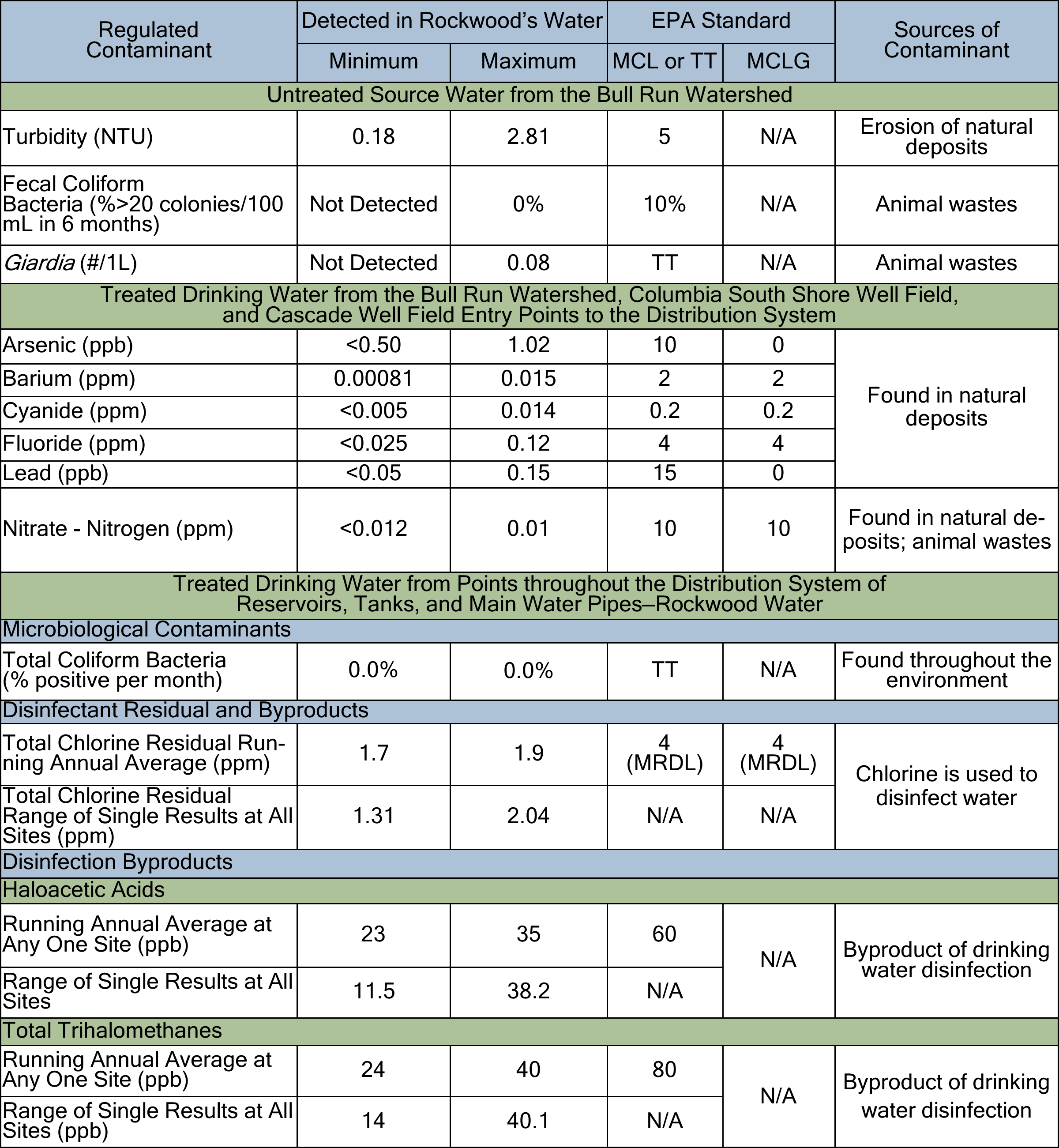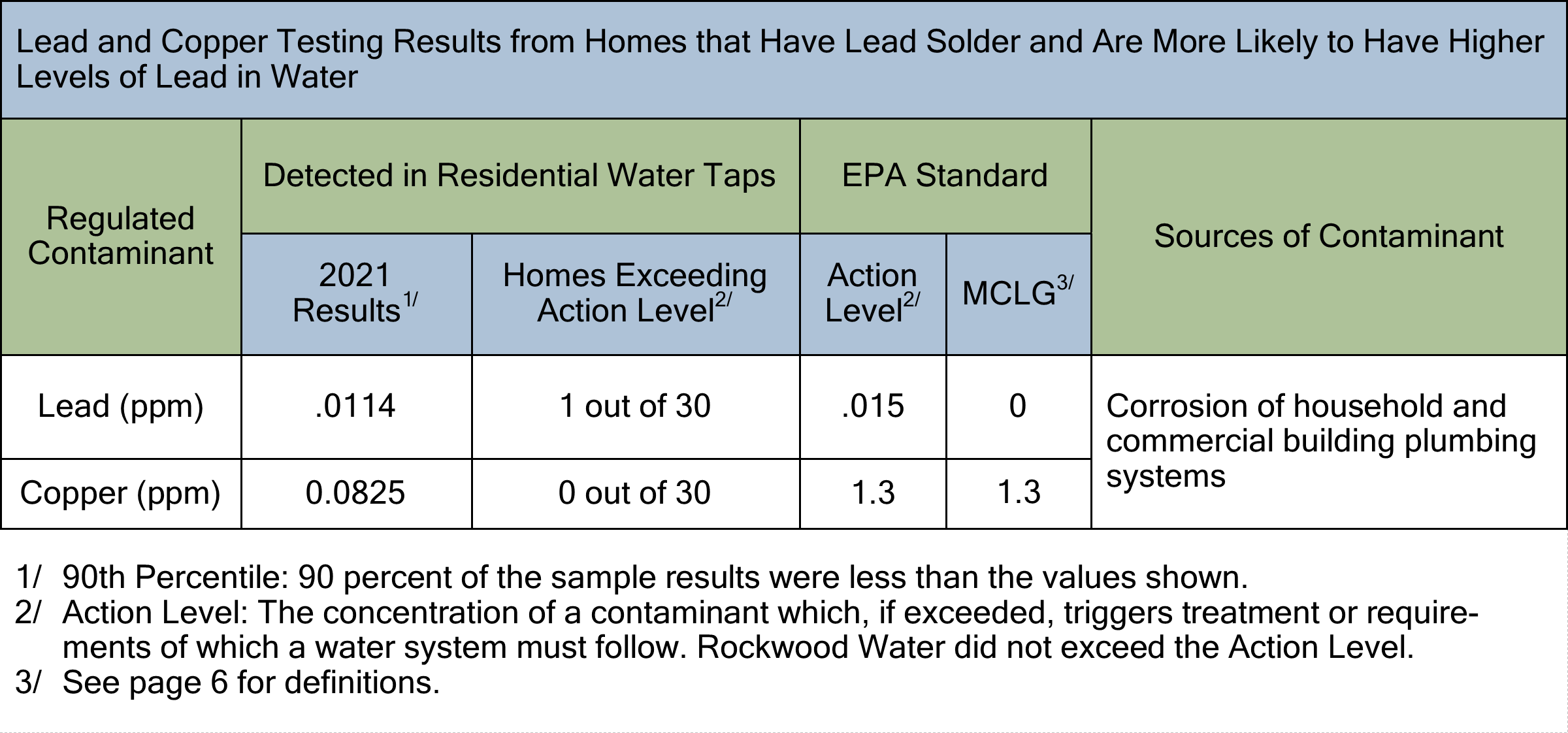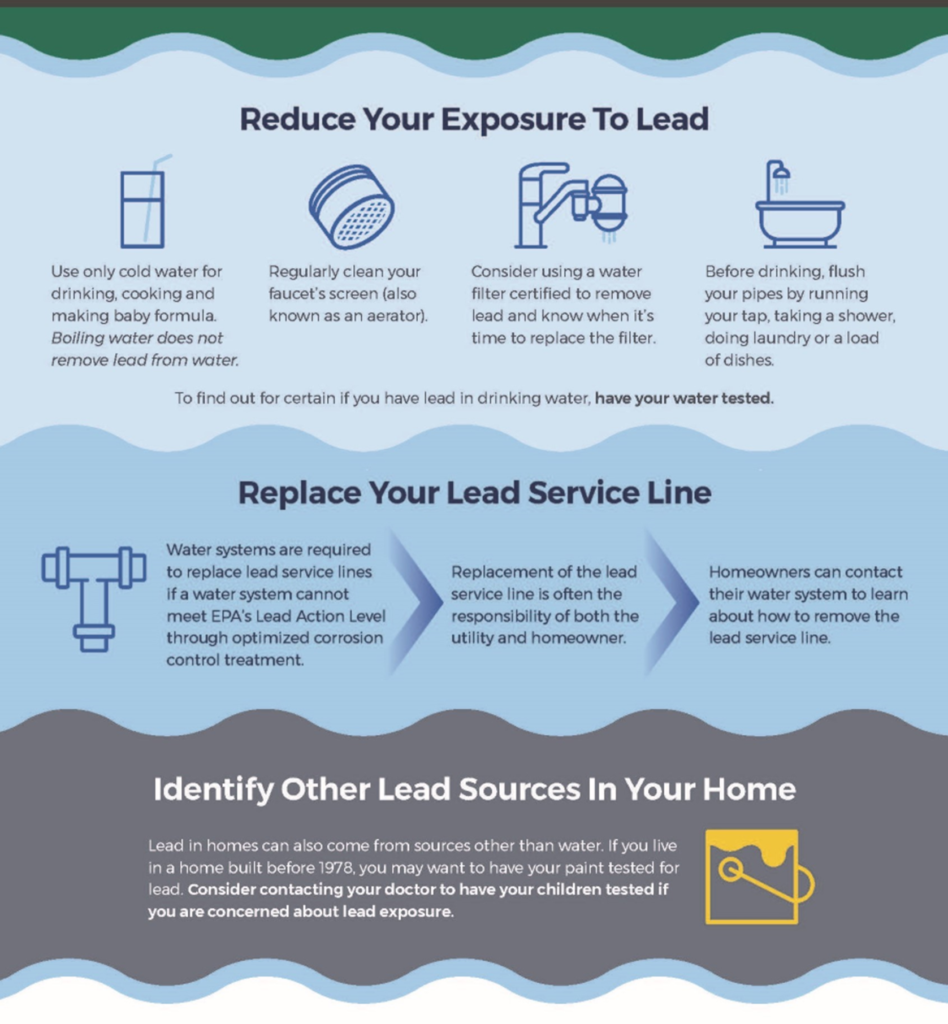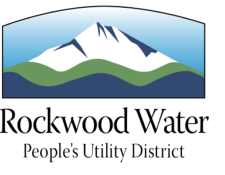This page can be translated into multiple languages. Click on the Google Translate button (upper right corner of page), choose the language, and click Translate.
We are pleased to present to our customers our annual Water Quality Report for 2022, which documents our water supply continues to meet state and federal regulations. Both English and Spanish printer friendly versions can be downloaded at the links below. If you would like a hard copy of either version, please contact the District office, and we will be happy to mail you one. If you have any questions, please contact us at 503-665-4179.
- Printer Friendly English Water Quality Report 2022
- Printer Friendly Spanish Water Quality Report 2022
2022 Water Quality Report
Rockwood customers, thank you for taking the time to read the Rockwood Water People’s Utility District 2022 Water Quality Report with water quality data from the 2021 calendar year. As your General Manager, I am happy to report the District continues to reliably provide excellent quality water that meets all state and federal safe drinking water requirements, at a cost to our consumers that is well below the regional average water bill.
This year has been an eventful time in the history of the District. We have made steady progress on the Cascade Groundwater Alliance source water development projects and are well on our way to building a sustainable, reliable and safe drinking water supply that is independent from the current Portland wholesale supply. The Cascade Reservoir #2 construction is well underway, large diameter water transmission pipelines are being installed, and the district has completed the drilling and started on the pump house construction for several of its new production wells. The next step in this project is to construct groundwater treatment facilities to remove manganese and iron from the water. Rockwood and Gresham will begin design on that part of the project this year and will be under construction between 2023-2025. This project is funded in part by a Federal Water Infrastructure Finance and Innovation Act (WIFIA) loan that will help minimize the total cost of our water to our ratepayers. I hope you take the opportunity to access the website to review the Water Quality Report and learn what the District team of water professionals do to keep the water flowing to your tap 24 hours per day, 365 days per year. If you have any questions, please contact us at 503-665-4179 or email customerservice@rwpud.org.
Sincerely,
Kari J. Duncan
General Manager
Public Participation Opportunities
Rockwood Water provides a variety of public information, public involvement & community outreach opportunities.
If you have questions about our programs, public meetings, or capital projects, please contact us at 503-665-4179 or visit rwpud.org to learn more.
Project Updates
Rockwood Water is excited to be working on the Groundwater Development Program conducted in partnership with the City of Gresham, called the Cascade Groundwater Alliance. This will remove the District’s dependence on a wholesale purchase contract with the City of Portland and allow local control over the water supply decisions which will result in long-term cost benefits for residents.
For updates on the Cascade Groundwater Alliance and its projects please visit: https:/rwpud.org/cascade-groundwater-alliance/
Translation
This report contains important information and should be translated. Do you need this document translated into another language? Go to rwpud.org/ccr2022.pdf and use the Google Translator button to choose from more than 100 languages.
Este informe contiene información importante y debe traducirse. ¿Necesita este documento traducido a otro idioma? Ve a rwpud.org/ccr2022.pdf y usa el botón Google Translator para elegir entre más de 100 idiomas.
Этот доклад содержит важную информацию и должен быть переведен. Вам нужен этот документ, переведенный на другой язык? Перейдите на rwpud.org/ccr2022.pdf и используйте кнопку Google Translator, чтобы выбрать из более чем 100 языков.
Regional Water Providers Consortium
Rockwood Water People’s Utility District is a member of the Regional Water Providers Consortium. The Consortium provides leadership in the planning, management, stewardship, and resiliency of drinking water in the Portland metropolitan region. Visit their website at regionalh2o.org to find out how to start your emergency prep with water, get information and resources to use water efficiently at home, and to learn more about the region’s drinking water.
Drinking Water Sources and Protection
The Bull Run Watershed, Portland’s protected surface water supply, is in the Mount Hood National Forest, 26 miles from Portland. The Portland Water Bureau and the US Forest Service carefully manage the watershed to sustain and supply clean drinking water. In a typical year, the watershed receives an astounding 135 inches of precipitation (rain and snow), which flows into the Bull Run River and then into two reservoirs that store nearly 10 billion gallons of drinking water.
Source water assessments are completed to identify contaminants of concern for drinking water. For the Bull Run, the only contaminants of concern are naturally occurring microorganisms, such as Giardia, Cryptosporidium, fecal coliform bacteria, and total coliform bacteria. The Portland Water Bureau regularly tests Bull Run water for these microorganisms that live in virtually all freshwater ecosystems.
The Portland Water Bureau treats water to control organisms that could make people sick but does not currently treat for Cryptosporidium. Portland is installing filtration to remove Cryptosporidium and other contaminants from drinking water by 2027. Portland’s source water assessment is available at portland.gov/water/resources/source-water-assessment or by calling 503-823-7525.
The Columbia South Shore Well Field, Portland’s protected groundwater supply, provides drinking water from 25 active wells located in three different aquifers. The well field is between Portland International Airport and Blue Lake Park. Portland uses the well field for two purposes: to supplement the Bull Run supply in the summer, and to temporarily replace the Bull Run supply during turbidity events, maintenance activities, and emergencies.
The Columbia South Shore Well Field is beneath homes and businesses with a variety of potential contaminant sources. The deep aquifers that are the primary sources of water supply have natural geologic protection from pollutants present at the land surface. Portland, Gresham, and Fairview work together to protect the well field. The cities’ Groundwater Protection Programs work with residents and businesses in the well field to ensure that pollutants from this urban area do not impact the groundwater source.
To learn more about groundwater protection and find upcoming groundwater education events, visit portland.gov/water/groundwater.
The Cascade Well Field is jointly owned and operated by Rockwood Water People’s Utility District and the City of Gresham. Rockwood Water began using water from the Cascade wells in 2004, primarily during the summer months, as a supplement to Bull Run water. Groundwater from the Cascade wells is from the Sand and Gravel Aquifer located approximately 600 feet below the surface. Rockwood Water works with the Cities of Gresham and Fairview businesses to protect this important investment. For information about water from the Cascade wells, or the Groundwater Protection Program, please contact Rockwood Water at 503-665-4179.
Special Notice for Immunocompromised Persons
Some people may be more vulnerable to contaminants in drinking water than the general population. Immuno-compromised persons such as persons with cancer undergoing chemotherapy, persons who have undergone organ transplants, people with HIV/AIDS or other immune system disorders, some elderly, and infants can be particularly at risk from infections. These people should seek advice about drinking water from their health care providers. EPA/CDC guidelines on appropriate means to lessen the risk of infection by Cryptosporidium and other microbial contaminants are available from the Safe Drinking Water Hotline (800-426-4791).
Monitoring for Cryptosporidium
Cryptosporidium is a potentially disease-causing microorganism that lives in virtually all freshwater ecosystems. Drinking water treatment for Cryptosporidium is required by state and federal regulations. For five years, the Oregon Health Authority (OHA) did not require the Portland Water Bureau to treat for Cryptosporidium based on data showing that Cryptosporidium was rarely found in the Bull Run Watershed. Since 2017, test results have shown low-level detections of Cryptosporidium primarily during the rainy season. As a result, OHA determined that treatment is now necessary.
The Portland Water Bureau does not currently treat for Cryptosporidium, but is required to do so under drinking water regulations. Portland is working to install filtration by 2027 under a compliance schedule with OHA. In the meantime, the Portland Water Bureau is implementing interim measures such as watershed protection and additional monitoring to protect public health. Consultation with public health officials continues to conclude that the general public does not need to take any additional precautions.
Exposure to Cryptosporidium can cause cryptosporidiosis, a serious illness. Symptoms can include diarrhea, vomiting, fever, and stomach pain. People with healthy immune systems recover without medical treatment. According to the Centers for Disease Control and Prevention (CDC), people with severely weakened immune systems are at risk for more serious disease. Symptoms may be more severe and could lead to serious life-threatening illness. Examples of people with weakened immune systems include those with AIDS, those with inherited diseases that affect the immune system, and cancer and transplant patients who are taking certain immunosuppressive drugs.
The Environmental Protection Agency has estimated that a small percentage of the population could experience gastrointestinal illness from Cryptosporidium and advises that customers who are immunocompromised and receive their drinking water from the Bull Run Watershed consult with their health care professional about the safety of drinking the tap water.

What the EPA Says Can Be Found in Drinking Water
Across the United States, the sources of drinking water (both tap water and bottled water) include rivers, lakes, streams, ponds, reservoirs, springs, and wells. As water travels over the surface of the land or through the ground, it dissolves naturally-occurring minerals and, in some cases, radioactive material, and can pick up substances resulting from the presence of animals or from human activity.
In order to ensure tap water is safe to drink, the Environmental Protection Agency (EPA) has regulations that limit the amount of certain contaminants in water provided by public water systems and require monitoring for these contaminants. Food and Drug Administration regulations establish limits for contaminants in bottled water, which must provide the same protection for public health.
Contaminants in drinking water sources may include: microbial contaminants, such as viruses, bacteria, and protozoa from wildlife; inorganic contaminants, such as naturally-occurring salts and metals; pesticides and herbicides, which may come from farming, urban storm water runoff, or home and business use; organic chemical contaminants, such as byproducts from industrial processes or the result of chlorine combining with naturally-occurring organic matter; and radioactive contaminants, such as naturally-occurring radon.
Drinking water, including bottled water, may reasonably be expected to contain at least small amounts of some contaminants. The presence of contaminants does not necessarily indicate that water poses a health risk. More information about contaminants and potential health effects can be obtained by calling the EPA’s Safe Drinking Water Hotline (1-800-426-4791) or at epa.gov/safewater.
Definitions:
Action Level:
The concentration of a contaminant which, if exceeded, triggers treatment of other requirements which a water system must follow.
MCL – Maximum Contaminant Level
The highest level of a contaminant that is allowed in drinking water. MCLs are set as close to the MCLGs as feasible using the best available treatment technology.
MCLG – Maximum Contaminant Level Goal
The level of a contaminant in drinking water below which there is no known or expected risk to health. MCLGs allow for a margin of safety.
MRDL – Maximum Residual Disinfectant Level
The highest level of a disinfectant allowed in drinking water. There is convincing evidence that addition of a disinfectant is necessary for control of microbial contaminants.
MRDLG – Maximum Residual Disinfectant Level Goal
The level of a drinking water disinfectant below which there is no known or expected risk to health. MRDLGs do not reflect the benefits of the use of disinfectants to control microbial contaminants.
N/A – Not Applicable
Some contaminants do not have a health-based level or goal defined by the EPA.
NTU – Nephelometric Turbidity Units
The unit of measurement of turbidity, or cloudiness, of a water sample.
ppb – Part Per Billion
Water providers use ppb to describe a very small amount of a substance within the water. In time measurement, one part per billion is about 3 seconds out of 100 years.
ppm – Part Per Million
Water providers use ppm to describe a small amount of a substance within the water. In time measurement, one part per million is about 32 seconds out of one year.
piC/L – Picocuries Per Liter
Picocurie is a measurement of radioactivity.
TT – Treatment Technique
A required process intended to reduce the level of a contaminant in drinking water.
Notes on Contaminants
Arsenic, Barium, and Fluoride – These metals are elements found in the earth’s crust. They can dissolve into water in contact with natural deposits. At the levels found in Rockwood’s drinking water, they are unlikely to lead to negative health effects.
Fecal Coliform Bacteria – As part of Rockwood’s compliance with the filtration avoidance criteria of the Surface Water Treatment Rule, water is tested for fecal coliform bacteria before disinfectant is added. The presence of fecal coliform bacteria in source water indicates that water may be contaminated with animal wastes. This is measured in percent of samples with more than 20 colonies in 100 milliliters of water during any six-month period. Rockwood Water uses chlorine to control these bacteria.
Giardia – Wildlife in the watershed may be hosts to Giardia, a microorganism that can cause gastro-intestinal illness. The treatment technique (TT) is to remove 99.9 percent of Giardia cysts. Rockwood Water uses chlorine to control Giardia.
Haloacetic Acids and Total Trihalomethanes – Disinfection byproducts form when chlorine interacts with naturally-occurring organic material in the water. High levels of disinfection byproducts can cause health problems in people. Rockwood adds ammonia to form a more stable disinfectant, which helps minimize disinfection byproducts.
Nitrate/Nitrogen – Nitrate, measured as nitrogen, can lead to bacterial and algal growth in the water. At levels that exceed the standard, nitrate can contribute to health problems. At the levels found in Rockwood’s drinking water, nitrate is unlikely to lead to negative health effects.
Radon – Radon is a naturally occurring radioactive gas that cannot be seen, tasted, or smelled. Radon can be detected at very low levels in the Bull Run water supply and at varying levels in Rockwood’s groundwater supply. Based on the limited levels of radon in groundwater after aeration, people are unlikely to have negative health effects from radon in water. Find more information about radon from the EPA at epa.gov/radon.
Sodium – There is currently no drinking water standard for sodium. At the levels found in drinking water, it is unlikely to lead to negative health effects.
Total Chlorine Residual – Total chlorine residual is a measure of free chlorine and combined chlorine and ammonia in Rockwood’s distribution system. Chlorine residual is a low level of chlorine remaining in the water and is meant to maintain disinfection through the entire distribution system.
Total Coliform Bacteria – Coliforms are bacteria that are naturally present in the environment. Coliform bacteria usually do not make people sick. They are used as an indicator that other potentially-harmful bacteria may be present. If more than 5 percent of samples in a month are positive for total coliforms, an investigation must be conducted to identify and correct any possible causes. Rockwood Water uses chlorine to control these bacteria.
Turbidity: Turbidity is the cloudiness of a water sample. In Rockwood’s system, increased turbidity usually comes from large storms, which suspend organic material in Bull Run water. Increased turbidity can interfere with disinfection and provide an environment for microorganisms to grow. Since the Portland Water Bureau does not yet filter Bull Run water, the treatment technique (TT) is that turbidity cannot exceed 5 NTU more than 2 times in 12 months. When turbidity rises in the Bull Run source, Portland switches to its Columbia South Shore Well Field source.
Contaminants Detected in 2021


Lead & Copper Testing
Water Testing – Once each year, Rockwood Water collects water samples from a group of over 30 homes that have lead solder and are more likely to have higher levels of lead in water. Testing results exceed the federal action level for lead when more than 10 percent of results from these homes are above 15 parts per billion. In the most recent round of testing, less than 10 percent of homes exceeded the lead action level.

Portland Water Bureau Lead Hazard Reduction Program
Because Rockwood Water purchases some of our water from the Portland Water Bureau, we want you to know about the Portland Water Bureau’s Lead Hazard Reduction Program. It is a comprehensive approach to reduce exposure to lead. Through this program the Portland Water Bureau provides:
Corrosion Control Treatment: This treatment reduces corrosion of lead in plumbing by adding sodium hydroxide to the water, which increases the pH. To further reduce corrosion, Portland has begun the process of improving corrosion control treatment methods by 2022.
Education, Outreach and Testing: Funds agencies and organizations that provide education, outreach, and testing on all sources of lead.
Home Lead Hazard Reduction: Supports the Portland Lead Hazard Control Program to provide grants to minimize lead paint hazards in homes.

Lead Testing & Reduction
Anyone in Rockwood Water’s service area can test their water for lead for free through the Multnomah County LeadLine at www.leadline.org or 503-988-4000. Additional resources are also available from the LeadLine including: Free childhood blood level testing, free lead-in-water testing, free lead reduction services.
Reducing Exposure to Lead
Rockwood Water cares about the health of the families in our community and is committed to helping you. If present , lead at elevated levels can cause serious health problems, especially for pregnant people and young children. Lead in drinking water is primarily from materials and components associated with service lines and home plumbing.
Rockwood Water is responsible for providing high quality drinking water, but cannot control the variety of materials used in plumbing components. Lead is rarely found in Rockwood’s source waters and there are no known lead service lines in the water system. In Rockwood, lead enters drinking water from the corrosion (wearing away) of household plumbing materials containing lead. These materials include lead-based solder used to join copper pipe — commonly used in homes built or plumbed between 1970 and 1985 — and brass components and faucets installed before 2014.
The most common sources of lead exposure in our region are lead-based paint, household dust, soil, and plumbing materials. Lead is also found in other household objects such as toys, cosmetics, pottery, and antique furniture.
When your water has been sitting for several hours, you can minimize the potential for lead exposure by flushing your tap for 30 seconds to 2 minutes before using water for drinking or cooking. If you are concerned about lead in your water, you may wish to have your water tested. Information on lead in drinking water, testing methods, and steps you can take to minimize exposure is available from the Safe Drinking Water Hotline or at http://www.epa.gov/safewater/lead.
Easy Steps to Reduce Possible Exposure to Lead from Household Plumbing
- Run your water to flush the lead out.
- Use cold, fresh water for cooking and preparing baby formula. Lead from pipes dissolves more easily into hot water.
- Do not boil water to remove lead.
- Test your child for lead. Ask a doctor or call the LeadLine at www.leadline.org or 503-988-4000.
- Test your water for lead. Contact the LeadLine to find out how to get a FREE lead-in-water test.
- Consider using a filter rated to reduce lead. To find out more about water filter performance standards, contact NSF International at 800-NSF-8010 or www.nsf.org.
- Clean your faucet aerators every few months.
- Consider replacing old fixtures. Since 2014, all pipes, fittings and fixtures are required to contain less than 0.25% lead.

